Tired of muddy paws and patchy lawns? This constant, messy struggle is frustrating. Artificial grass offers a clean, consistent, and beautiful solution for you and your dog.
To train your dog to use fake grass, choose a spot and lead them there on a leash during potty times. Use a consistent command like "Go potty." When they succeed, immediately reward them with praise and a special treat. Consistency and positive reinforcement are the most important parts.
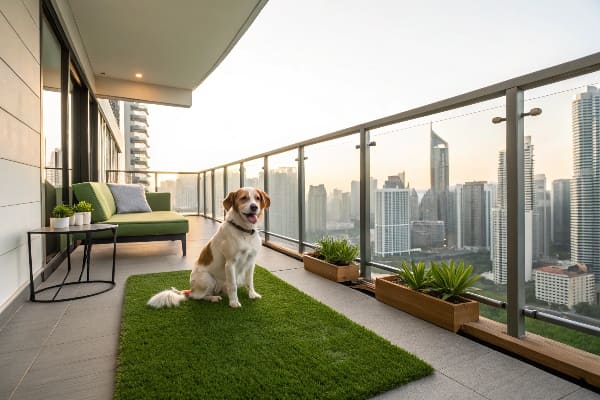
Training seems simple, but getting the setup right from the start makes a huge difference. A little preparation can save you a lot of time and prevent frustration for both you and your furry friend. Let’s walk through everything you need to know to make this process a success.
What should you consider before starting dog potty training?
Jumping into training without any preparation? This often leads to confusion for your dog and frustration for you. A little planning makes the whole training process much smoother.
Before you start, you need to consider the location of the grass pad and choose a high-quality, pet-safe artificial turf. Also, gather your supplies like high-value treats and an enzymatic cleaner1. A consistent plan is your most important tool for success.
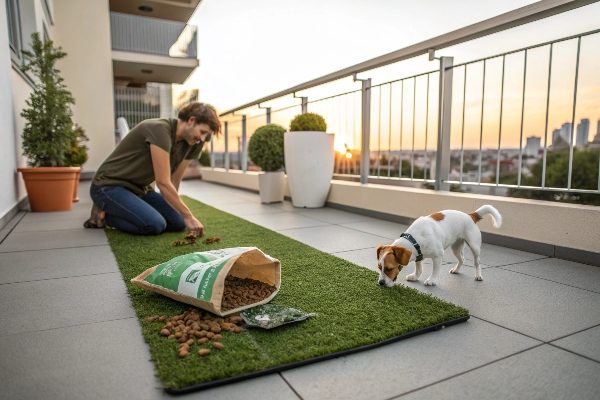
Based on my years in the artificial turf industry, I know that the quality of the product is the foundation for success. The same is true here. Starting with the right materials and a clear plan is half the battle. You are setting up an environment where it is easy for your dog to learn and succeed.
Choosing the Right Turf
Not all fake grass is the same. For dogs, you need a product that is durable, safe, and has excellent drainage. Look for turf made from polyethylene or polypropylene, as these materials are non-toxic and soft on paws. Good drainage is critical to prevent odors from building up. At QH Grass, we ensure our turf has a high-quality backing that allows liquids to pass through easily, which is essential for a pet potty area.
Selecting the Perfect Spot
Consistency is key. Choose one designated spot for your dog’s potty area and stick to it. This spot should be easy for your dog to access. If you have a yard, pick a corner. If you live in an apartment, a balcony is a great option. Make sure the spot is comfortable and not in a loud, scary area.
Gathering Your Supplies
Having everything ready before you start makes the process feel less like work. A simple checklist can help you stay organized.
| Item | Purpose |
|---|---|
| High-Quality Fake Grass | Provides a durable, safe, and well-draining spot. |
| High-Value Treats | Motivates and rewards your dog for correct behavior. |
| Enzymatic Cleaner | Breaks down and eliminates odors, not just masks them. |
| Leash | Helps guide your dog to the designated spot. |
What are the exact steps to train a dog on an artificial grass pad?
Are you feeling unsure about where to begin with the actual training? Making random attempts can confuse your dog and slow down your progress. Following a clear, step-by-step method helps your dog learn fast.
First, let your dog get used to the new grass. Then, lead them to it on a leash during potty times and use a cue word like "Go potty." When they go, give them immediate and enthusiastic praise, followed by a delicious treat. Repetition is key.
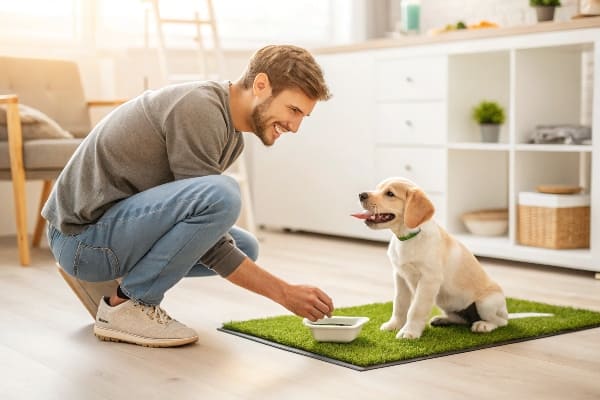
I’ve helped many customers choose turf for their pets, and I always tell them that patience is just as important as the product. Every dog learns at a different pace. Don’t get discouraged. Just follow the steps, stay positive, and celebrate the small wins along the way. Your dog wants to please you; you just need to show them how.
Step 1: Introduction and Familiarization
Before you start training, let your dog explore the new artificial grass. Let them sniff it, walk on it, and even play on it. Toss a toy or a few treats onto the grass to create a positive association. You want them to feel comfortable and see the new surface as a good place.
Step 2: Establishing a Routine
Dogs thrive on routine. Take your dog to the artificial grass pad at specific times every day. These should include:
- First thing in the morning
- Right after waking up from a nap
- A few minutes after every meal
- Just before bedtime
Always take them on a leash so you can guide them directly to the right spot.
Step 3: Using a Command and Reward
Choose a simple command, such as "Go potty" or "Do your business," and say it in a calm, encouraging voice when you get to the spot. The moment your dog starts to urinate or defecate, praise them gently. Once they finish, give them lots of praise and a high-value treat immediately. The reward must happen right after the action so they connect the two.
Step 4: Patience and Repetition
This is the most important step. You have to repeat this process over and over. Some dogs might understand in a few days, while others might take a few weeks. If your dog doesn’t go, don’t worry. Take them back inside and try again in 15-20 minutes. Just stay consistent.
What do you do when your dog refuses to use the fake grass?
Is your dog being stubborn and avoiding the new potty spot? This can feel like a big setback and might make you want to give up. Don’t worry, there are simple tricks to overcome this common problem.
If your dog refuses to use the grass, first make sure there are no health issues. Then, try making the spot more appealing with a potty attractant spray2. You can also place a piece of their old, soiled sod on it. Never punish accidents.

Sometimes, a small change can make a big difference. One of my clients was struggling because their puppy wouldn’t go near the new turf. We figured out the turf was on a noisy part of their balcony. They moved it to a quieter corner, and the problem was solved. It’s often about seeing things from your dog’s perspective.
Making the Spot More Attractive
Dogs navigate the world by scent. If the new grass smells strange, they might avoid it.
- Use Attractants: You can buy potty training sprays that are designed to attract dogs. A few sprays on the turf can encourage them to go there.
- Transfer Scent: This is a very effective trick. If your dog has an accident elsewhere, soak it up with a paper towel and place the towel under the artificial grass. Or, if they poop outside, move one piece onto the fake grass. This tells them, "This is a bathroom spot."
Re-evaluating Your Method
If you’re still not having success, take a step back and look at your process.
- Are you being consistent? Are you taking them out at the same times every day?
- Is the reward good enough? Some dogs need a more exciting treat to be motivated.
- Is the location okay? Make sure the spot is not too hot, too loud, or in a high-traffic area that makes your dog nervous.
The Importance of Not Punishing
Never scold or punish your dog for having an accident in the wrong place. This will only create fear and anxiety, which makes training much harder. They might become afraid to go to the bathroom in front of you at all. Just calmly clean up any messes with an enzymatic cleaner and stick with your positive training plan.
How do you properly clean artificial grass after your dog uses it?
Are you worried about bad smells and hygiene on your new lawn? A dirty artificial lawn can become smelly and unsanitary, which completely defeats its purpose. Proper cleaning is simple and will keep your grass fresh.
To clean up, remove solid waste immediately. Rinse the area where your dog urinates with a hose every day or two. For a deep clean, use a gentle enzymatic cleaner or a mix of water and vinegar weekly to eliminate any lingering odors.
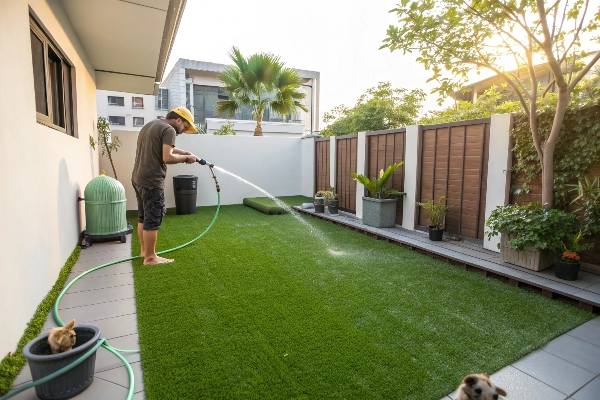
In my work, I’ve seen that the best artificial turf systems have great drainage. This is so important for pet owners. Water and urine need to flow through the turf and its backing easily. This design makes cleaning much simpler and more effective. A quick rinse can do wonders if the turf is built right.
A Simple Cleaning Schedule
Keeping your artificial grass clean is easy if you stay on top of it. A regular routine prevents odors and bacteria from building up.
| Task | Frequency | Method |
|---|---|---|
| Solid Waste Removal | Immediately | Scoop it up and dispose of it, just like on a regular lawn. |
| Urine Rinse | Daily or every other day | Use a hose to rinse the dog’s favorite potty spot thoroughly. |
| Deep Clean | Weekly or bi-weekly | Apply an enzymatic cleaner, let it sit for a few minutes, then rinse. |
| Brushing | Monthly | Brush the grass fibers with a stiff broom to keep them standing tall. |
Why Enzymatic Cleaners Are Best
Standard soaps or detergents might make the grass smell nice for a little while, but they don’t solve the real problem. Dog urine contains ammonia and bacteria that cause odors. An enzymatic cleaner contains special enzymes that break down and destroy this bacteria. This eliminates the smell at its source instead of just covering it up. A simple solution of equal parts white vinegar and water can also work well to neutralize the ammonia smell.
Why is artificial turf ideal for homes with dogs?
Still wondering if fake grass is really worth it? You might be weighing the initial cost against the constant work of maintaining a real lawn. The long-term benefits for dog owners make it a fantastic investment.
Artificial turf is perfect for dogs because it means no more muddy paws, no yellow urine spots, and no holes from digging. It is extremely durable, safe, easy to clean, and provides a beautiful, green play area for your pet all year long.
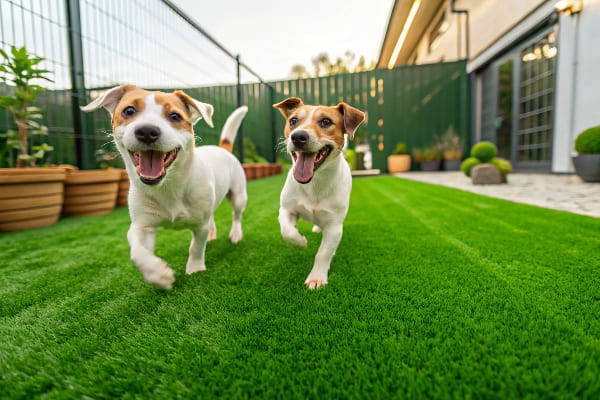
Over the years, I’ve supplied turf for everything from professional sports fields to beautiful home landscapes. I strongly believe that the biggest advantage is giving people back their time. For pet owners, this means less time spent on yard work and cleaning, and more quality time playing with your best friend. That’s a success in my book.
Unbeatable Durability and Cleanliness
One of the main reasons people switch is cleanliness.
- No Mud: Even after a heavy rain, your dog can play outside and come back in with clean paws.
- No Patches: Dog urine can kill real grass, leaving ugly yellow spots. Artificial turf is not affected.
- No Digging: The durable backing prevents even the most determined diggers from turning your lawn into a mess.
Safety and Health
A healthy pet is a happy pet. Artificial grass contributes to a safer environment.
- No Chemicals: You don’t need any toxic pesticides, fertilizers, or weed killers that could harm your dog.
- Fewer Pests: Artificial turf doesn’t provide a good home for fleas, ticks, and other pests.
Artificial Grass vs. Real Grass for Dogs
| Feature | Artificial Grass | Real Grass |
|---|---|---|
| Cleanliness | No mud, easy to rinse clean. | Constantly muddy, can get waterlogged. |
| Durability | Resists digging and urine spots. | Easily damaged by digging and pet urine. |
| Maintenance | Simple rinsing and occasional deep cleaning. | Mowing, watering, fertilizing, re-seeding. |
| Pest Control | Naturally reduces pests like fleas and ticks. | Can harbor many pests and insects. |
Conclusion
Training a dog to use fake grass requires patience. But with high-quality turf and a consistent, positive method, you’ll create a clean, durable, and beautiful space for your best friend.
_画板-1.png)
_画板-1.png)